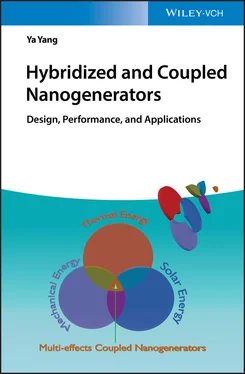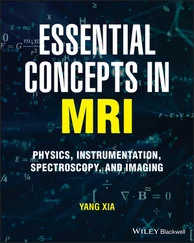Ya Yang - Hybridized and Coupled Nanogenerators
Здесь есть возможность читать онлайн «Ya Yang - Hybridized and Coupled Nanogenerators» — ознакомительный отрывок электронной книги совершенно бесплатно, а после прочтения отрывка купить полную версию. В некоторых случаях можно слушать аудио, скачать через торрент в формате fb2 и присутствует краткое содержание. Жанр: unrecognised, на английском языке. Описание произведения, (предисловие) а так же отзывы посетителей доступны на портале библиотеки ЛибКат.
- Название:Hybridized and Coupled Nanogenerators
- Автор:
- Жанр:
- Год:неизвестен
- ISBN:нет данных
- Рейтинг книги:3 / 5. Голосов: 1
-
Избранное:Добавить в избранное
- Отзывы:
-
Ваша оценка:
- 60
- 1
- 2
- 3
- 4
- 5
Hybridized and Coupled Nanogenerators: краткое содержание, описание и аннотация
Предлагаем к чтению аннотацию, описание, краткое содержание или предисловие (зависит от того, что написал сам автор книги «Hybridized and Coupled Nanogenerators»). Если вы не нашли необходимую информацию о книге — напишите в комментариях, мы постараемся отыскать её.
Hybridized and Coupled Nanogenerators — читать онлайн ознакомительный отрывок
Ниже представлен текст книги, разбитый по страницам. Система сохранения места последней прочитанной страницы, позволяет с удобством читать онлайн бесплатно книгу «Hybridized and Coupled Nanogenerators», без необходимости каждый раз заново искать на чём Вы остановились. Поставьте закладку, и сможете в любой момент перейти на страницу, на которой закончили чтение.
Интервал:
Закладка:
Forewords
Maxwell's equations are fundamental key equations in physics, which are the foundation of modern wireless communication, light communication, and energy science. Nanogenerators (NGs) are based on utilizing Maxwell's displacement current as the driving force to effectively convert mechanical energy into electricity, regardless of whatever used materials are nano or not. To date, NGs have attracted extensive interest due to potential applications as self‐powered sensor networks, small power sources, and even large‐scale blue energy harvesting. Hybridized NGs are based on integrating different NGs into a system that can simultaneously/individually scavenge the different types of energies in our living environment, so that a stable and sustainable power supply can be obtained by using whatever energy is available in the environment. Since we reported the first hybrid NGs in 2009 (Chen Xu, Xudong Wang, and Zhong Lin Wang, Nanowire structured hybrid cell for concurrently scavenging solar and mechanical energies, JACS , 131, 2009, 5866–5872), a variety of NGs based on different structures have been demonstrated, including mechanical energy, solar energy, thermal energy, and even chemical energy. In recent years, hybridized NGs also include the integration of different NGs to scavenge the same type of energy but using different methods for largely enhancing the energy conversion efficiency. Part of this book will give a detailed summary about the design, performance, and applications of hybridized nanogenerators.

Zhong Lin Wang, Professor
Laureate of Albert Einstein World Award of Science
Laureate ENI award
Regents' Professor and Hightower Chair Professor
School of Materials Science and Engineering
Georgia Institute of Technology, USA
Director and Chief Scientist
Beijing Institute of Nanoenergy and Nanosystems, Chinese Academy of Sciences
Multifunctional materials have attracted more and more interest due to potential applications in energy scavenging units, sensors, and physical sciences. As one of the multifunctional materials, many ferroelectric materials have piezoelectric, pyroelectric, photovoltaic, and triboelectric effects, where the coupling among these effects is interesting. By utilizing these multifunctional materials, various one‐structure‐based coupled nanogenerators have been achieved to simultaneously or individually scavenge different energies from the living environment wherever and whenever any energy is available. The core of coupled nanogenerators is the multifunctional material, so that looking for the high‐performance materials is very important to realize the maximized complementary scavenging of multiple energies from the ambient environment. Moreover, coupled nanogenerators have potential applications in multifunctional sensors due to the use of the same materials and electrodes, resulting in higher resolution, smaller volume, and lower cost as compared with those of various integrated sensors reported for the simultaneous detection of multi‐physical signals. Some new physical effects such as thermo‐phototronic effect are based on the coupled nanogenerators, where the new coupling enhancement phenomenon has been found between the thermoelectric and photovoltaic effects in some semiconducting materials. Part of this book will give a detailed summary about the design, performance, and applications of coupled nanogenerators.

Yue Zhang, Professor
Department of Materials Physics and Chemistry
School of Materials Science and Engineering
University of Science and Technology Beijing, China
Member of the Chinese Academy of Sciences
Preface
Scavenging multiple energies from our living environment is of critical importance to meet stable and sustainable energy needs. Various energies such as mechanical, thermal, and solar energies are not always available at the same time due to the weather or the working conditions. Nanogenerators are based on utilizing the Wang term ∂ P s/ ∂t as the driving force to convert energies into electricity, regardless of whatever used materials are nano or not. The purpose of developing hybridized and coupled nanogenerators is to simultaneously or individually scavenge multi‐mode energies from the environment; while hybridized nanogenerators are based on integrating the different nanogenerators into a system to scavenge the same or different energies for enhancing the energy conversion efficiency, and coupled nanogenerators are based on one material and one structure‐based energy scavenging device with the same electrodes but different energy harvesting functionalities. Several new physical effects including pyro‐phototronic effect, ferro‐pyro‐phototronic effect, and thermo‐phototronic effect are based on the coupled nanogenerators; while both the pyro‐phototronic effect and thermo‐phototronic effect are focused on the semiconducting materials, the ferro‐pyro‐phototronic effect is focused on the ferroelectric materials. These physical effects have potential applications in solar cells, photodetectors, light emission diodes, and so on.
In this book, we present a comprehensive discussion about the design, performance, and applications of hybridized and coupled nanogenerators. The recent advancements have been summarized including wind‐driven triboelectric nanogenerators, electromagnetic–triboelectric hybridized nanogenerators, photovoltaic–pyroelectric coupled nanogenerators, multi‐effects coupled nanogenerators, and some new physical effects. The advantages and challenges of hybridized and coupled nanogenerators are discussed, and related perspectives on the opportunities for materials and new physical effects have been summarized.
Chapter 1 (contributor: Ya Yang) introduces the overall development of hybridized and coupled nanogenerators. The hybridized nanogenerators include hybrid energy cells, electromagnetic–triboelectric hybridized nanogenerators, and other hybridized nanogenerators. The coupled nanogenerators include pyroelectric and photovoltaic coupled nanogenerators and multi‐effects coupled nanogenerators. The corresponding applications are also discussed.
Chapters 2 and 3 (contributors: Yang Wang, Ya Yang) discuss the recent development of wind‐driven triboelectric nanogenerators and electromagnetic–triboelectric hybridized nanogenerators. The different working mechanisms with the different devices are introduced. The device working modes, structures, materials, performances, and applications are summarized.
Chapter 4 (contributors: Kai Song, Ya Yang) introduces the other hybridized nanogenerators, which includes hybridized photoelectric and piezoelectric nanogenerators, hybridized photoelectric and triboelectric nanogenerators, and hybridized photoelectric and pyroelectric nanogenerators.
Chapter 5 (contributors: Bangsen Ouyang, Ya Yang) summarizes the various devices by hybridizing nanogenerators and sensors. The sensors include pressure, strain, temperature, and magnetic sensors, and photodetectors. The performance parameters of these sensors include sensitivity, response speed, and stability.
Chapters 6 and 7 (contributors: Ding Zhang, Ya Yang) discuss the recent progress in the development of hybridizing nanogenerators and energy storage devices for simultaneous energy harvest and storage, and thermal energy technologies including pyroelectric and thermoelectric nanogenerators. Focus will be on materials selection, structure designs, performance optimization, and potential applications of different nanogenerators and nanogenerator‐based energy harvest and storage devices. Particularly, the effects of nanomaterials with various morphologies and different structure designs on the performance of devices are compared and analyzed systematically. Finally, the opportunities, challenges, and perspectives these devices face within the energy field are discussed.
Читать дальшеИнтервал:
Закладка:
Похожие книги на «Hybridized and Coupled Nanogenerators»
Представляем Вашему вниманию похожие книги на «Hybridized and Coupled Nanogenerators» списком для выбора. Мы отобрали схожую по названию и смыслу литературу в надежде предоставить читателям больше вариантов отыскать новые, интересные, ещё непрочитанные произведения.
Обсуждение, отзывы о книге «Hybridized and Coupled Nanogenerators» и просто собственные мнения читателей. Оставьте ваши комментарии, напишите, что Вы думаете о произведении, его смысле или главных героях. Укажите что конкретно понравилось, а что нет, и почему Вы так считаете.












